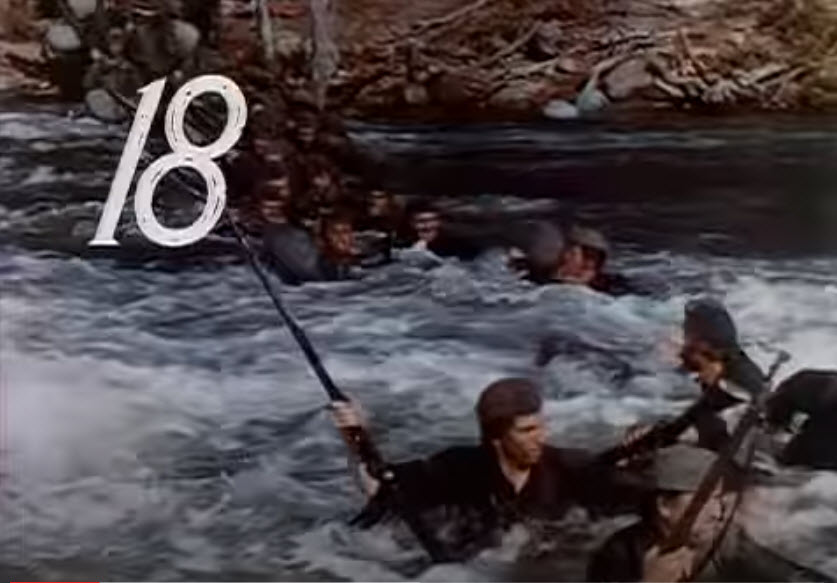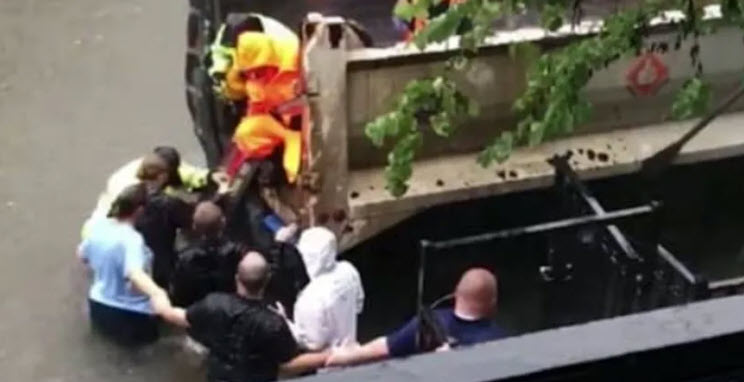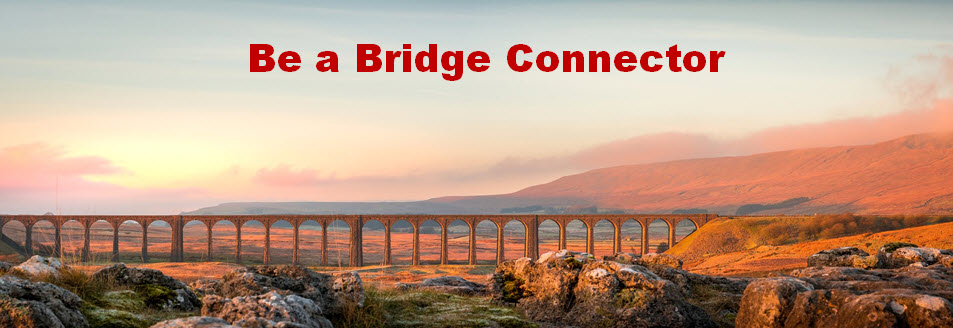Building a Bridge Across the Raging River

There is a compelling and unforgettable scene in the movie, Northwest Passage, where the Rangers come to the shore of a raging river. They must get across to the other side. As you watch this scene in the movie unfold, first their fearless leader, Robert Rogers, played by Spencer Tracy, gets into the raging river and he wraps his arms around a tree root on the river’s edge.
The next Ranger gets out into the raging river and he locks arms with the first man. The third man gets out into the wild rushing current and locks arms with the second man.
Slowly, the human chain gets built out across the river. The brave men enter the raging river, locking arms, person by person, until they get all the way across the river. The last man wraps his arms around a tree root at the shoreline on the far side of the river.
Now that the human bridge is in place going all the way across the river, the rest of the men ford their way across the river using the “human bridge” as a support to get across the river.
Once all the men cross the river safely, then the human bridge begins to disassemble. Then Ranger leader, Robert Rogers, who was first to get into the river lets go of the tree roots and makes his way across the river. Once he is all the way across, the man who held the position next to him unlocks arms and makes his way across the river. This continues until one by one, the human bridge disassembles until the last man on the far side of the river, releases his grip on the tree root and steps out of the river.
This very same technique, of forming a human bridge was used successfully to a save a pregnant woman and her unborn’s life just last year. It was the height of hurricane Harvey in Houston. The streets were overflowing with floodwaters. Andrea Smith had gone into labor, and there was trouble. She desperately needed to get to the hospital. Her husband had tried calling 911, Homeland Security but the lines were busy and he could not get through.
The neighbors came to their rescue. One of the neighbors sent a message to an acquaintance whose father lives near a fire station. He alerted the firefighters and a rescue mission was hatched.
An oversized dump truck came lumbering down their street, ready to pick up Andrea and get her to the hospital. Now the problem was how to get Andrea through the swift and deep floodwaters and up onto the high bed of the truck.
One by one, the neighbors form a human chain in the waist high floodwaters, locking arms with one another.

Andrea and her husband Greg, were able to navigate through the floodwaters and climb up onto the dump truck. Then they were driven to the nearest hospital, where Andrea gave birth to baby Adeielle Smith. These Houston neighbors used the same life saving maneuver.
Why do I bring this up? This scene in the movie from Northwest Passage, and this true life story coming out of Hurricane Harvey gives us a very important parable to consider.
The Parable of Crossing the River using a Human bridge
What do the wild waters of the raging river represent? The strong current can represent the flow and the pull of the world and the world system. More specifically, it is the domain of HaSatan. Any one of us can be pulled downstream in the current of this world system.
What does the “near” shore and the “far” shore represent?
In the bible, “near” is code for the Southern kingdom, Judah.
“Far” is code for the Northern kingdom, Ephraim.
Daniel uses this code language in his prayer of repentance in Daniel 9:7:
“O Lord, righteousness belongs to You, but to us shame of face, as it is this day—to the men of Judah, to the inhabitants of Jerusalem and all Israel, those near and those far off in all the countries to which You have driven them, because of the unfaithfulness which they have committed against You.
This same code language is also used by Paul as he describes the wall that separates between Jew and non-Jew in Ephesians 2:11-13:
Therefore remember that you, once Gentiles in the flesh—who are called Uncircumcision by what is called the Circumcision made in the flesh by hands—that at that time you were without Christ, being aliens from the commonwealth of Israel and strangers from the covenants of promise, having no hope and without God in the world. But now in Christ Jesus you who once were far off have been brought near by the blood of Christ.
And came and preached peace to you which were afar off, and to them that were near. For through him we both have access by one Spirit unto the Father. Ephesians 2:17
It is the picture of a chasm that needs to be bridged. What kind of chasm?
The chasm between man on earth and the God of Israel in heaven.
The chasm between Judaism and Christianity.
The chasm found in a broken marriage, or a broken relationship.
The chasm between Northern kingdom (Ephraim) and Southern kingdom (Judah)
So, the function and the role of the human chain is to build a bridge between God and man, to join Jew to Christian and Christian to Jew, to join one brother to another. It is the ministry of reconciliation. Coming from where I stand in the river, Yeshua the Messiah is a central focal point of this bridge, for it is through HIM that we are reconciled to the God of Israel and to one another.
What are some other takeaways and principles that can be gleaned from this parable?
*One man alone could not get across the river. It took a TEAM.
*Each man had to hold his specific position on the human chain.
*One man was anchored to tree roots on the “near” side of the river. What this man believes “doctrinally” in the faith community could be quite different than what the other man anchored on the “far side” of the river believes “doctrinally”.
*All had an important role to play.
*Building the human bridge can be to the saving of lives! It is a “life giving” maneuver.
*There was a coming together, a uniting and a locking of arms for the purpose of saving lives.

What is the application of this parable to the body of Christ?
There have been efforts over the years by various ministries to “bridge the gap” between Jews and Christians. Ministries such as ICEJ, CUFI, Bridges for Peace, HaYovel, Christian Friends of Israel have sprung up and flourished to build a friendship bridge between Jews and Christians. Many of these ministries have brought forth good fruit!
A Message for the Hebrew Roots Community
Now let me take a moment to address the Messianic/Hebrew roots community. This community has grown and flourished in the last 35 years. Many heeded the call to “Come out of her my people”. They withdrew from the Christian mainstream. They formed home groups and small fellowships and began to celebrate and keep the Sabbath and the biblical feasts.
Perhaps the Lord had us in a “wilderness place” as an island unto ourselves for His purposes—so we could develop an identity as a people and a grow in our understanding of the Hebrew roots of the Christian faith.
Now I wish to pose a question for those in the Hebrew roots community to consider and reflect upon. Have we become an “island unto ourselves”? Are we no longer extending the hand of fellowship and friendship to our mainstream Christian brothers and sisters? How many Christian relationships do you have? Would you visit a Sunday church? Or, would you be “tarred and feathered” for even considering such a notion?
I would submit to you that NOW is the time to break out, break forth and break through. Now is the time to become human “bridge connectors” to the saving of lives. I believe the time of isolation unto ourselves is over. NOW is the time to purposefully and intentionally extend the hand of grace, fellowship and friendship on BOTH sides of the river, to our mainstream Christian brethren and to our Jewish brethren.
Why now? I believe that it is time to build the human chain, the human bridge across the raging river—to the saving of lives. We NEED each other. We must break down the walls of isolation. We cannot build this human bridge alone.
There will be those who are positioned on the “near” side of the river. There will be those positioned on the “far” side of the river. There will be those in the “middle” of the river. And those of us in the “middle” of the river (I am thinking of the Hebrew roots community) must no longer form a circle facing each other and isolate from others. It is time to unite and lock arms to form that human bridge across the river.

You May Also Like
